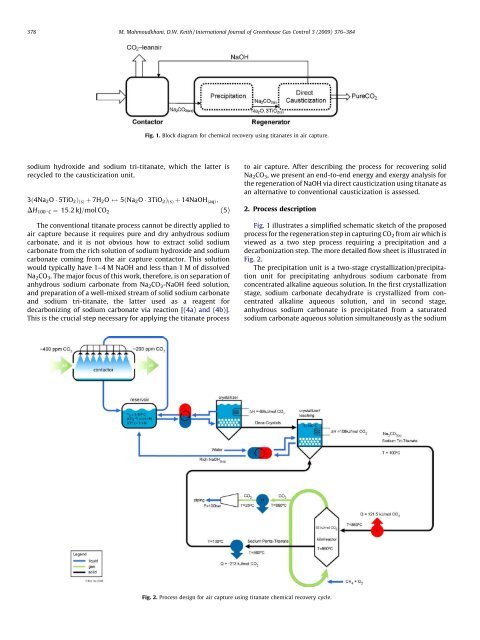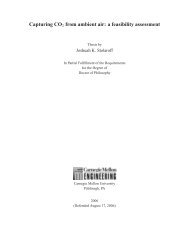Low-energy sodium hydroxide recovery for CO2 ... - David Keith
Low-energy sodium hydroxide recovery for CO2 ... - David Keith
Low-energy sodium hydroxide recovery for CO2 ... - David Keith
Create successful ePaper yourself
Turn your PDF publications into a flip-book with our unique Google optimized e-Paper software.
378<br />
M. Mahmoudkhani, D.W. <strong>Keith</strong> / International Journal of Greenhouse Gas Control 3 (2009) 376–384<br />
Fig. 1. Block diagram <strong>for</strong> chemical <strong>recovery</strong> using titanates in air capture.<br />
<strong>sodium</strong> <strong>hydroxide</strong> and <strong>sodium</strong> tri-titanate, which the latter is<br />
recycled to the causticization unit.<br />
3ð4Na 2 O 5TiO 2 Þ ðsÞ þ 7H 2 O $ 5ðNa 2 O 3TiO 2 Þ ðsÞ þ 14NaOH ðaqÞ ;<br />
DH 100 C ¼ 15:2kJ=mol CO 2 (5)<br />
The conventional titanate process cannot be directly applied to<br />
air capture because it requires pure and dry anhydrous <strong>sodium</strong><br />
carbonate, and it is not obvious how to extract solid <strong>sodium</strong><br />
carbonate from the rich solution of <strong>sodium</strong> <strong>hydroxide</strong> and <strong>sodium</strong><br />
carbonate coming from the air capture contactor. This solution<br />
would typically have 1–4 M NaOH and less than 1 M of dissolved<br />
Na 2 CO 3 . The major focus of this work, there<strong>for</strong>e, is on separation of<br />
anhydrous <strong>sodium</strong> carbonate from Na 2 CO 3 -NaOH feed solution,<br />
and preparation of a well-mixed stream of solid <strong>sodium</strong> carbonate<br />
and <strong>sodium</strong> tri-titanate, the latter used as a reagent <strong>for</strong><br />
decarbonizing of <strong>sodium</strong> carbonate via reaction [(4a) and (4b)].<br />
This is the crucial step necessary <strong>for</strong> applying the titanate process<br />
to air capture. After describing the process <strong>for</strong> recovering solid<br />
Na 2 CO 3 , we present an end-to-end <strong>energy</strong> and exergy analysis <strong>for</strong><br />
the regeneration of NaOH via direct causticization using titanate as<br />
an alternative to conventional causticization is assessed.<br />
2. Process description<br />
Fig. 1 illustrates a simplified schematic sketch of the proposed<br />
process <strong>for</strong> the regeneration step in capturing CO 2 from air which is<br />
viewed as a two step process requiring a precipitation and a<br />
decarbonization step. The more detailed flow sheet is illustrated in<br />
Fig. 2.<br />
The precipitation unit is a two-stage crystallization/precipitation<br />
unit <strong>for</strong> precipitating anhydrous <strong>sodium</strong> carbonate from<br />
concentrated alkaline aqueous solution. In the first crystallization<br />
stage, <strong>sodium</strong> carbonate decahydrate is crystallized from concentrated<br />
alkaline aqueous solution, and in second stage,<br />
anhydrous <strong>sodium</strong> carbonate is precipitated from a saturated<br />
<strong>sodium</strong> carbonate aqueous solution simultaneously as the <strong>sodium</strong><br />
Fig. 2. Process design <strong>for</strong> air capture using titanate chemical <strong>recovery</strong> cycle.








